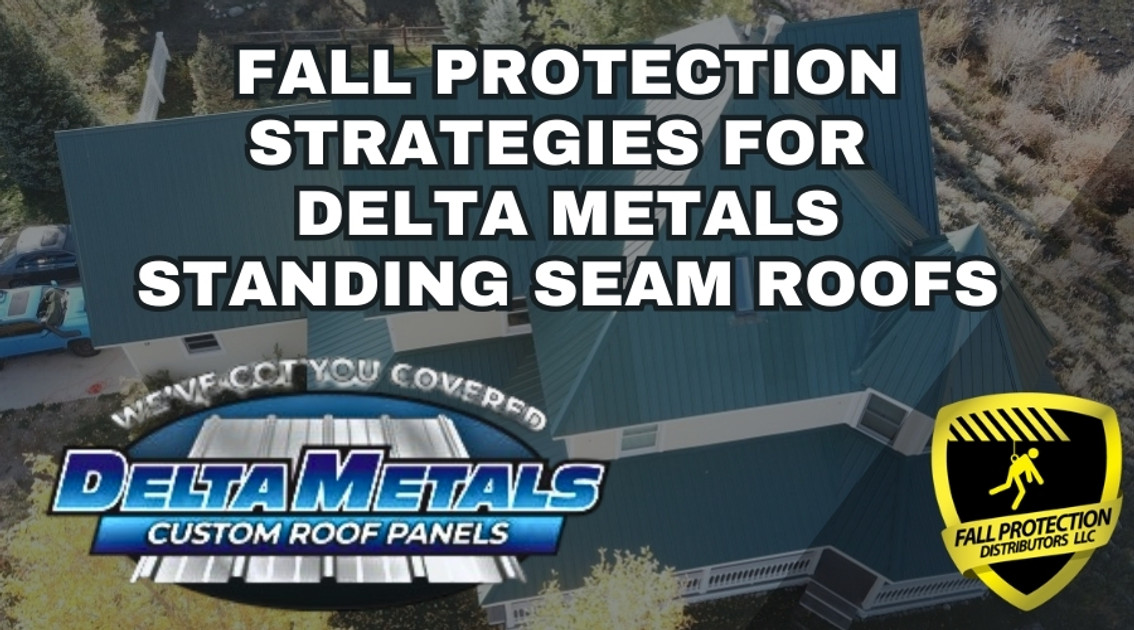Delta Metals - Compatible Fall Protection Anchors For The 1.5 Snap-Lock Roofs
Posted by Howie Scarboro - CEO Fall Protection Distributors, LLC on Sep 16th 2025
See the Roof Anchor Compatibility Chart for Delta Metals Standing Seam Panels.

Who Is Delta Metals?
Delta Metals is a Colorado-based manufacturer and wholesaler of metal roofing panels with facilities in Delta and Hayden.
Since 2008, the company has focused on producing high-quality metal roofing and siding systems that combine durability, energy efficiency, and long-term performance. By working directly with local building supply retailers, Delta Metals ensures that its products are readily accessible, conveniently sourced, and supported by knowledgeable customer service.
Delta Metals manufactures every panel with eco-friendly materials and responsible processes, minimizing environmental impact while delivering exceptional strength and reliability. Delta Metals offers a wide range of profiles for residential, commercial, and agricultural applications, backed by industry-leading turnaround times that keep projects moving forward without delay. Their reputation rests not only on the quality of their products but also on their commitment to clear communication and swift problem resolution.
With a focus on craftsmanship, innovation, and sustainability, Delta Metals consistently sets a high standard for metal roofing and siding manufacturing across the region.

Why Are Compatible Fall Protection Anchors Critical For Standing Seam Roofs?
Standing seam metal roofs excel under demanding conditions, offering excellent weather resistance, energy efficiency, and a long service life.
However, these benefits depend on preserving the integrity of the seams. Traditional anchors that rely on drilling or penetration create vulnerabilities, allowing water intrusion, reducing wind performance, and potentially voiding warranties. Even a single screw hole can compromise the system's watertight design, leading to costly repairs down the line.
Proper fall protection anchors are essential for worker safety on standing seam roofs. OSHA requires a 100% tie-off when working at heights, and standing seam roofs present unique challenges due to their smooth surfaces and steep pitches.
Crews achieve the safest and most reliable tie-off by using compatible, non-penetrating anchors, such as seam-mounted systems that clamp securely without drilling. These anchors create strong tie-off points that keep crews OSHA-compliant while preserving the roof's structure and warranty. For steeper roof applications, ridge-mounted solutions like the Ridge Pro provide continuous tie-off from ladder to ridge and back, again without compromising panel performance.
By matching the fall protection system to the roof design, contractors safeguard their crews and clients' investments. Crews working on Delta Metals standing seam roofs must use non-penetrating anchors, as they are critical for providing lasting protection and peace of mind.
1.5 Inch Snap-Lock Panels

The Delta Snap-Lock 1.5 panel combines clean lines with long-term durability, making it a versatile choice for roofing and siding applications.
The 1.5-inch seams and a 16-inch coverage width panel also feature clean lines with a hidden fastener mounting system. The result is a sleek finish that enhances curb appeal while delivering the performance needed for demanding environments. See the Roof Anchor Compatibility Chart for Delta Metals 1.5 Inch Snap-Lock Standing Seam Panels.
Delta's default profile is striated, which helps reduce oil canning and provides additional panel strength. Customers also have the option of a two-bead rib or a flat pan profile, catering to different design preferences. Panels up to 26 feet are fabricated in-house and delivered to the retailer or jobsite. In comparison, panels longer than 26 feet are run on-site for precision and convenience.
Delta Metals produces these panels in 26-gauge and 24-gauge steel, with 22-gauge offered only in weathering steel, to ensure strong performance. The system requires specialized clips for secure installation. It carries a Sherwin-Williams 40-year paint warranty, ensuring color retention and protection against the elements. Recommended primarily for roofing, the Delta Snap-Lock 1.5 blends strength, style, and reliability.
Fall Protection for 1.5 Inch Snap Lock Panels
Compatibility depends on the panel gauge, so crews can protect workers without compromising panel performance.
22-gauge and 24-gauge steel
- SSRA1 Seam Anchor: Non-penetrating, lightweight seam clamp that attaches to the rib without drilling. Crews position it where anchors are needed, torque it to the manufacturer's specification, and gain a reliable tie-off point that preserves watertight seams and paint warranties. The aluminum body is light enough to move, yet strong enough for fall arrest or restraint when installed correctly.
- SSRA2 Adjustable Roof Jack Adapters: Attach on top of SSRA1 seam anchors to support 10-foot wooden walk boards. This device creates a stable staging area for panel handling, fastener placement, and trim work, reducing fatigue and improving footing across steep roof panels while keeping the roof free of penetrations.
- SSRA3 Anchor Plates: Mount on top of two SSRA1 seam anchors to create connection points for lifelines and lanyards. These aluminum spanner plates serve as the end anchoring points for 100-foot temporary horizontal lifeline systems.
- SSRA HLL 100-foot Temporary Horizontal Lifeline Kit: Spans up to 100 feet between approved anchors so multiple workers can move laterally while remaining tied off. The kit includes four SSRA1 seam anchors, two SSRA3 Anchor Plates, and a 100-foot temporary horizontal lifeline.
- Super Anchor 120-foot Permanent Horizontal Lifeline Kit: An engineered solution for facilities that require routine roof access. Once installed and commissioned, crews return to a pre-installed system that supports scheduled maintenance with routine access.
- Ridge Pro Steep Assist Anchor: Peak-mounted device that crews place over the ridge with a lightweight 16-foot extension pole. It establishes a tie-off point before the first step onto the panels and provides continuous protection along ridges on roofs from 6:12 to 12:12. The design avoids panel penetrations, facilitating a quick setup from the ladder.
26-gauge steel
- Ridge Pro Steep Assist Anchor: Use on roofs from 6:12 to 12:12. Crews set it over the peak with a 16-foot extension pole to secure a tie-off before stepping onto the roof surface. This approach maintains a 100 percent tie-off from the ladder to the ridge and back, while protecting lighter gauge seams from clamp loads.
Metal Roof Anchor Panel Compatibility For Delta Metals
| 1.5 Inch Snap Lock 22 ga. | 1.5 Inch Snap Lock 24 ga. | 1.5 Inch Snap Lock 26 ga. | |
|---|---|---|---|
SSRA 1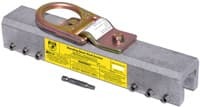 |
YES | YES | NO |
SSRA1 Nylon Tip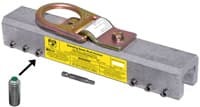 |
YES | YES | NO |
SSRA2 Roof Jack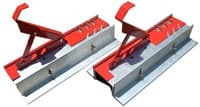 |
YES | YES | NO |
SSRA3 Anchor Plate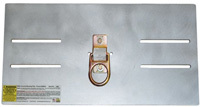 |
YES | YES | NO |
The Ridge Pro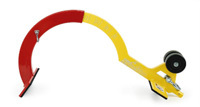 |
YES | YES | YES |
Contact Us For More Information
For further details on roofing solutions and fall protection systems, please get in touch with us at 863-703-4522 or www.StandingSeamRoofAnchor.com. Let's work together to make your roofing projects safe, beautiful, and built to last. For more safety tips, refer to OSHA's 48-page Fall Protection Manual. Once you have determined the most suitable anchors for your roof system, download our free Anchor Inspection Form.
Safety Tips For Standing Seam Roofs
Ensure Proper Footwear for Stability
Safe footing begins with the proper boots. Roofing-specific footwear features deep tread, flexible soles, and solid ankle support, keeping workers stable on slick, sloped, or dusty surfaces. Good shoes do more than prevent slips—they reduce fatigue, improve balance, and keep crews sharp throughout the day.
Develop OSHA-Compliant Safety Plans
A safety plan should be more than paperwork—it's the framework for every task. Clear plans identify hazard zones, outline tie-off points, and assign responsibilities. Crews who know the plan don't hesitate; they stay organized, communicate better, and complete jobs safely and efficiently.
Set Up Protective Guardrail Barriers for Work Zones
Guardrails provide passive protection that never wavers. Once installed around roof edges, skylights, and access points, they create clear boundaries and prevent missteps. Even when distractions are high, guardrails quietly safeguard crews, letting them focus on their work without second-guessing their footing.
Use Specialized Anchor Systems for Standing Seam Roofs
Standing seam panels require anchors that are designed explicitly for them. Drilling into seams risks leaks, warped ribs, and voided warranties. Seam-mounted, non-penetrating anchors clamp tightly without leaving holes, creating OSHA-compliant tie-off points that protect both the worker and the roof system. Avoid seam anchors that require attachment over panel clips, as these are impossible to locate on existing roofs. Set screws are superior to compression-style anchors, as the set screws don't crush the seam between plates of metal.
Encourage the Use of Trauma Straps
A harness can stop a fall, but suspension trauma can quickly turn into a serious threat. Trauma straps enable workers to shift their weight, improve circulation, and maintain stability while waiting for rescue. Lightweight and inexpensive, they are an essential safeguard that should come standard with every harness.
Promote a Culture of Safety
Rules alone don't create safe job sites—people do. Daily briefings, mutual trust, and open communication foster a culture where workers look out for one another. When safety becomes second nature, crews stay more alert, more engaged, and far less likely to overlook hazards.
Install Permanent Roof Anchor Systems
Sites with ongoing roof access benefit from permanent anchors. These fixed tie-off points eliminate the need for constant setup and dismantling, reducing the risk of mistakes and saving time. Crews step onto the roof knowing anchors are already in place, making every visit faster and safer.
Consult Experts for Curved Metal Panels
Curved and radius roof systems introduce challenges that standard anchors cannot solve. A fall protection specialist can evaluate seam geometry and stress points, then recommend customized lifelines or anchors. Expert guidance ensures that unique rooflines remain safe without compromising their structural integrity or safety.
Equip Workers with High-Quality Safety Gear
The best fall protection plan fails without reliable gear. Crews ensure safety by wearing harnesses that fit comfortably, regularly inspecting lanyards and SRLs, and using components that meet OSHA standards. When crews trust their equipment, they use it correctly, consistently, and with confidence.
Prioritize Ladder Safety Training
Many accidents occur before workers ever reach the roof. Training crews to inspect ladders, set them using the 4-to-1 rule, and climb with three points of contact drastically reduces incidents. Ladder safety is simple to teach, easy to practice, and saves lives.
Disclaimer
The views, recommendations, and information presented in this blog are solely those of the author and do not necessarily reflect the opinions or positions of the featured panel manufacturer, its brands, subsidiaries, or parent companies. Customers are strongly encouraged to contact the roof panel manufacturer directly for inquiries regarding fall protection compatibility with their products and to address any potential warranty issues that may arise after installing our products.

